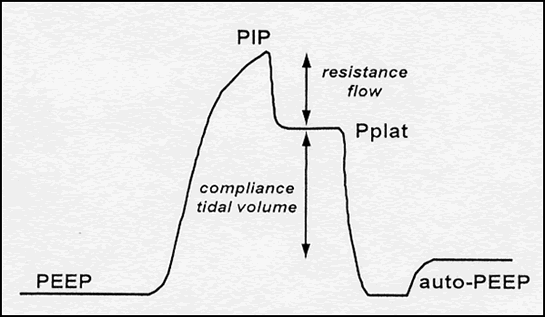Contraindications to Invasive Mechanical Ventilation
In general, intubation and mechanical ventilations should not be used in the following circumstances:
- No indication for ventilatory support exists (see Table 3 [31k PDF*])
- Noninvasive ventilation is indicated in preference to invasive mechanical ventilation
- Intubation and mechanical ventilation are contrary to the patient’s expressed wishes
- Life-support interventions, including mechanical ventilation, would constitute medically futile therapy
 Top of Page
Top of Page
Types and modes of mechanical ventilation
A confusing assortment of possible ways to mechanically ventilate a patient’s lungs is available to the clinician, and these ways are distinguished by numerous variables. Phase variables are used to initiate one of the three phases (trigger, limit, and cycle) of the ventilatory cycle.
- The trigger variable, which causes inspiration to begin, can be a preset pressure variation (pressure triggering), a preset volume (volume triggering), a designated flow change (flow triggering), or an elapsed time (time triggering).
- The limit variable is the pressure, volume, or flow target that cannot be exceeded during inspiration. An inspiration may thus be limited when a preset peak airway pressure is reached (pressure limiting), when a preset volume is delivered (volume limiting), or when a preset peak flow is attained (flow limiting).
- Cycling refers to the factors that terminate inspiration. A breath may be pressure, volume, or time cycled when a preset pressure, volume, or flow as time interval has been reached, respectively.
Three different types of breath can be provided during mechanical ventilation, depending upon whether the ventilator or the patient does the work and whether the ventilator or the patient initiates (triggers) the breath. These types are mandatory, assisted, and spontaneous breaths.
- Mandatory breaths are machine cycled, and are triggered, limited, and cycled by the ventilator. The patient is entirely passive, and the ventilator performs the work of breathing.
- Assisted breaths are like mandatory breaths in that they are limited and cycled by the ventilator, but are triggered by the patient. Breathing work is thus partly provided by the ventilator and partly by the patient.
- Spontaneous breaths are triggered, limited, and cycled by the patient, who performs all the work of breathing.
The relationship between the various possible types of breath and the inspiratory phase variables just discussed is called a mode of ventilation. Table 4 [30k PDF*] lists and describes the modes currently available for positive-pressure ventilatory support.
The distinction between volume-targeted and pressure-targeted ventilation is clinically important. Volume-targeted modes deliver a fixed tidal volume (Vt) with each breath. This means that airway pressure during a given breath can vary depending on the resistance to airflow during inspiration and on the patient’s lung and chest wall compliance.
Fig 1

Figure 1: Pressure profile of a volume-targeted breath in which flow is interrupted at end-inspiration, allowing measurement of the quasi-static properties of the respiratory system. PEEP, positive end-expiratory pressure; PIP, peak inspiratory pressure; Pplat, end-inspiratory plateau pressure; auto-PEEP, pressure above the set level of PEEP that is generated by dynamic hyperinflation due to incomplete exhalation in the presence of obstructive lung disease.
As shown in Figure 1, the pressure profile of a volume-targeted breath has several components. Once the breath has been delivered, an end-inspiratory hold maneuver can be performed to measure the static or plateau pressure (Pplat). The latter is a reflection of lung distention and is used to calculate the static compliance of the respiratory system (equals DV/DP). During inspiration, airway pressure reflects the resistance to flow as well as the compliance of the system. Thus, an increase in inspiratory flow, bronchospasm, or airway secretions increases PIP, but does not directly affect Pplat.
 Top of Page
Top of Page
< Previous:
Free Pulmonary Course on Mechanical Ventilation | Next:
Volume-Targeted Modes